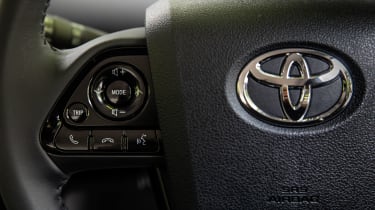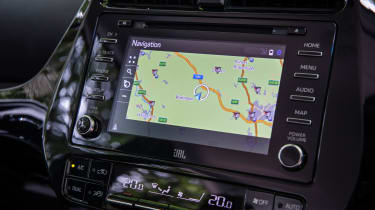Toyota Prius (2016-2022) review - Interior, design and technology
The Prius' wacky exterior looks and unusual cabin may not be to everyone's liking

The Prius’s sharp styling is in stark contrast to its predecessor, but many of the design flourishes also serve a purpose when it comes to aerodynamic efficiency.
At the front, the bonnet drops away, while the bumper features two defined creases at either side to give the Toyota a sharp leading edge. This helps the car cut through the air with the least resistance possible, and other details such as the squared-off tail and relatively low roofline ensure it has a low drag rating.
This hasn’t come at the expense of visual interest, though. While the Toyota’s looks won’t be to everyone’s tastes, and are potentially more divisive than rivals such as the Ioniq and Niro, there’s no denying they make an impression. Neat features such as the thin S-shaped LED tail-lamps, bright running lights plus striking slashes and vents mean the Prius makes a statement.
If you thought the outside of the Toyota Prius was wacky, the inside is just as mad. Toyota has continued the styling theme into the cabin with a shapely, futuristic design. Yet unlike the Mk3 Prius, it doesn’t feel forced, and neither does it ask you to compromise when it comes to practicality or equipment.
Used - available now

2020 Toyota
Prius
34,796 milesAutomaticPetrol1.8L
Cash £16,100
2018 Toyota
Prius
62,262 milesAutomaticPetrol1.8L
Cash £11,963
2020 Toyota
Prius
38,900 milesAutomaticPetrol1.8L
Cash £16,951
2020 Toyota
Prius
50,351 milesAutomaticPetrol1.8L
Cash £17,500The Prius is not a sports car, so the dashboard doesn’t wrap itself around the driver; it doesn’t feel cosy for either front seat occupant. Instead it feels like you’re on the deck of a spaceship, with a 'floating' upper screen containing all sorts of driving information.
In the centre of the dash is a touchscreen infotainment system. It runs Toyota’s Touch 2 system which is very easy to use; the only real complaint is that there are touch-sensitive buttons around the screen for different menus and functions, but they need a firm prod to work and sometimes require you to take your eyes off the road to operate them. We’re glad Toyota has finally fitted Android Auto and Apple CarPlay as standard, so you can skip the outdated Toyota system and use your phone’s features instead - including navigation.
There are some clever touches inside too, such as the passenger air vent – this only blows air when it senses a passenger sitting there, otherwise it shuts off to help save fuel. The driving position is greatly improved over older Prius models – the seats are firm but supportive and thanks to plenty of adjustment in the seat and in the steering column, it’s easy to get comfortable.
Overall cabin quality is improved over previous Prius models. The upper part of the dashboard is covered in squidgy soft-touch plastic on ‘Business Edition’ models and above, but from the middle to low parts of the cabin, there are lots of the scratchy plastics.
It feels well screwed together, but we’d guess it wouldn’t take too long for some of the materials to mark. The low dash makes it feel spacious inside, while material quality is good. Most surfaces are covered in soft-touch plastic, while white inlays also brighten the interior.
There are four trim levels. ‘Active’ is the entry grade, but it’s well equipped and comes with dual-zone climate control, keyless entry (driver’s door) and start, Toyota Touch 2, DAB radio, driver’s seat electric lumbar adjustment, adaptive cruise control, road sign assist, lane departure alert, automatic high beam lights and forward collision warning with autonomous emergency braking. There are also 15-inch alloy wheels and LED headlights.
‘Business Edition’ is, unsurprisingly, aimed at business users and adds the plusher, soft-touch plastic interior, a wireless phone charger, a colour head-up display, blind spot monitor, rear cross traffic alert, heated front seats, a leather-covered steering wheel and auto-dimming rear view mirror.
‘Business Edition Plus’ comes with 17-inch alloys, Toyota Touch 2 with Go (sat-nav), park assist and front and rear parking sensors. Top-drawer ‘Excel’ is more designed for the private buyer, and has leather seats, an upgraded JBL stereo, rain-sensing wipers and an upgraded Touch 2 system with sat-nav and more internet connectivity functions.
The Plug-in Prius is largely the same as the standard hybrid, but all-new front and rear treatments mean it’s even more distinctive. And the revised design goes more than skin deep. For example, the tailgate is constructed of lightweight carbon fibre-reinforced plastic, plus you can add a £1,500 solar roof panel to help charge the batteries when the car is parked or on the move.
Inside, the Plug-in looks almost identical to the normal Prius. The quality of the materials isn’t up to the standard of a VW Golf’s, but the Toyota’s cabin is solidly built and the bold design helps it stand out from its conservative rivals.
Sat-nav, stereo and infotainment
There's a seven-inch touchscreen in the Prius, but it’s not as sharp or as clear as the display you'll find in a Hyundai Ioniq. The glossy screen also picks up fingerprints and is harder to view in bright conditions, because it shows more reflections.
The nav system is easy enough to use, but the menu layout is clunkier than the Hyundai’s app-like icons that mean it works more like a smartphone. The Prius’s unit also isn’t quite as responsive as the Ioniq’s, while the live traffic information isn’t as accurate, either.
There are plenty of driver coaching features to maximise efficiency, including a data logger that shows you how efficiently you've been driving in terms of a percentage score, which you'll soon be trying to improve on with every drive. Wireless phone charging is also a nice touch, yet the whole system lacks a little polish.
Only range-topping Business Edition Plus and Excel models come with the upgraded premium JBL sound system, and it’s not available on other models even as an option.









